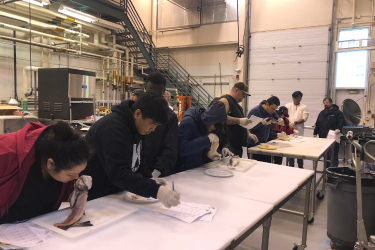Scientific diving is an essential research tool and maintaining researcher safety is the top priority. NOAA Fisheries collects a ton of data from the ocean to better understand marine ecosystems and sustainably manage our fisheries.
Collecting these data in underwater environments presents unique challenges, including:
- Limited visibility underwater
- Varying temperatures
- Handling scientific equipment underwater while maintaining neutral buoyancy
- Ensuring that data is collected accurately and safely
- Monitoring diving parameters (breathing gas, time, depth, decompression status) while conducting research
Our divers undergo intense training and learn detailed safety protocols in order to complete this important job safely. NOAA divers from the Southeast Fisheries Science Center must complete extensive annual dive training. This guarantees they are equipped to handle the unique challenges of working underwater.
Dive Training
Training for scientific diving includes:
- In-water diving skills
- Academic instruction
- Watermanship assessment
- CPR/First Aid/Emergency Oxygen certification
- Dive rescue scenario drills
Practicing diving skills such as mask removal, regulator recovery, and air sharing teaches divers to safely adapt to unexpected situations in the field. Rescue drills require divers to practice and demonstrate their skills in emergency situations both individually and as a team.
Assessments to evaluate stamina and comfort in the water ensure divers have the physical fitness and confidence needed for an intense dive schedule. Divers may dive up to six dives a day and a maximum of 10 consecutive days of diving. It is important that divers review their dive instruction and training materials annually.
Any research that requires diving contains at least one NOAA divemaster or lead diver. There are currently eight divemasters at the Southeast Fisheries Science Center facility in Miami who see to the safety and success of diving operations. NOAA divemasters receive additional specialized training from the NOAA Dive Center.
Emphasizing safety training and adherence to safety protocols allows researchers to make important contributions to our understanding and management of coral reefs. It also minimizes the risks inherent to underwater data collection.
With the annual training requirements met, these NOAA divers are eager to apply their honed skills to the many NOAA diving projects.
Southeast NOAA Fisheries Dive Units
NOAA has more than 30 active diving units across the continental United States and its territories. Six of these units are in the southeast within NOAA Fisheries; Southeast Fisheries Science Center divers work in dive units in Beaufort, North Carolina, Miami and Panama City, Florida, Pascagoula, Mississippi and Galveston, Texas. Additionally, the NOAA Fisheries Southeast Regional Office in St. Petersburg, Florida has a diving unit. The Miami dive unit is the second most active diving program in NOAA. In 2022, Miami divers conducted more than 1,100 dives, accounting for 25 percent of all NOAA scientific dives for the year. This translates to more than 25 days and nights underwater.
The Miami Dive Unit
The Miami dive unit has one dive medical technician who is trained in operational diving medicine and emergency care. This provides an additional level of safety on remote diving missions. The skills of a dive medical technician are similar to that of a paramedic, with specialized training in dive-specific injuries and the operation of hyperbaric recompression chambers.
There are several NOAA Fisheries research groups that heavily rely on scientific diving to achieve their goals. The largest diving-focused research programs at the Center’s Miami location are the Coral Reef Ecology and Coral Research and Assessment Laboratories.
Diving for Data
The information collected by divers helps us provide the science and data needed to effectively manage marine life of the Southeast Region and Atlantic high seas. Thanks to these teams and their extensive training, NOAA Fisheries divers in the Southeast are well prepared to keep “diving for data”!






